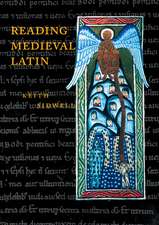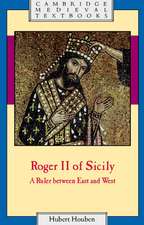Byzantium: The Surprising Life of a Medieval Empire
Autor Judith Herrinen Limba Engleză Paperback – 31 aug 2009
| Toate formatele și edițiile | Preț | Express |
|---|---|---|
| Paperback (2) | 70.32 lei 25-31 zile | +26.82 lei 6-12 zile |
| Penguin Books – 2 apr 2008 | 70.32 lei 25-31 zile | +26.82 lei 6-12 zile |
| Princeton University Press – 31 aug 2009 | 162.49 lei 22-36 zile |
Preț: 162.49 lei
Nou
31.09€ • 32.55$ • 25.88£
Carte disponibilă
Livrare economică 10-24 martie
Specificații
ISBN-10: 0691143692
Pagini: 391
Ilustrații: 42 halftones. 8 color photos.
Dimensiuni: 152 x 231 x 25 mm
Greutate: 0.66 kg
Editura: Princeton University Press
Locul publicării:Princeton, United States
Cuprins
List of Maps xii
Introduction: A Different History of Byzantium xiii
Part I: Foundations of Byzantium
Chapter 1: The City of Constantine 3
Chapter 2: Constantinople, the Largest City in Christendom 12
Chapter 3: The East Roman Empire 22
Chapter 4: Greek Orthodoxy 33
Chapter 5: The Church of Hagia Sophia 50
Chapter 6: The Ravenna Mosaics 61
Chapter 7: Roman Law 70
Part II: The Transition from Ancient to Medieval
Chapter 8: The Bulwark Against Islam 83
Chapter 9: Icons, a New Christian Art Form 98
Chapter 10: Iconoclasm and Icon Veneration 105
Chapter 11: A Literate and Articulate Society 119
Chapter 12: Saints Cyril and Methodios,'Apostles to the Slavs� 131
Part: III: Byzantium Becomes a Medieval State
Chapter 13: Greek Fire 141
Chapter 14: The Byzantine Economy 148
Chapter 15: Eunuchs 160
Chapter 16: The Imperial Court 170
Chapter 17: Imperial Children,"Born in the Purple" 185
Chapter 18: Mount Athos 192
Chapter 19: Venice and the Fork 203
Chapter 20: Basil II,"The Bulgar-Slayer" 212
Chapter 21: Eleventh-Century Crisis 220
Chapter 22: Anna Komnene 232
Chapter 23: A Cosmopolitan Society 242
Part IV: Varieties of Byzantium
Chapter 24: The Fulcrum of the Crusades 255
Chapter 25: The Towers of Trebizond, Arta, Nicaea and Thessalonike 266
Chapter 26: Rebels and Patrons 281
Chapter 27: "Better the Turkish Turban than the Papal Tiara" 299
Chapter 28: The Siege of 1453 310
Conclusion: The Greatness and Legacy of Byzantium 321
Further Reading 339
List of Emperors Named in the Text 354
Chronology 357
Maps 363
Acknowledgements 375
Index 377
Textul de pe ultima copertă
"This book provides an introduction to Byzantium in a nonconventional fashion. It explores, in chronological order, basic questions about Byzantine history and society. I know of no other book that attempts this approach to the millennium-long history of Byzantium. Judith Herrin is a scholar at the top of her form."--Michael Maas, author of Exegesis and Empire in the Early Byzantine Mediterranean
"A very readable and enjoyable introduction to Byzantium. Judith Herrin is a major scholar of Byzantium with much to teach us."--Robert Ousterhout, author of Master Builders of Byzantium
Recenzii
Offering a brilliant study of the history of the Byzantine empire, Herrin...draws [an] original portrait of a tradition-based yet dynamic empire that protected Christianity by checking the westward expansion of Islam. Drawing on letters, journals and other primary documents from both political figures and ordinary citizens, Herrin splendidly recreates an empire whose religious art, educational curriculum, tax and legal systems, and coronation rituals preserved the best of the empire's pre-Christian Greek past while at the same time passing along advances to the rest of the world. Herrin's history is hands-down the finest introduction to Byzantium and its continuing significance for world history.
The book is comprehensive, but the paragraphs are never dense and the prose retains throughout a lively quality.
The big, standard histories contain a wearying succession of emperors, patriarchs, battles, and sieges...At the other end of the scale there are lightweight travelogues, or books that pick out the juiciest moments (such as the final siege of 1453), leaving aside many things that are more important but less conducive to a good story. Judith Herrin has tried to find a middle ground between those two extremes, and has succeeded in a rather original way. Her book is a necklace of short chapters, each on a different topic, strung out in broadly chronological order. Some are devoted to places (Ravenna, Mount Athos and, of course, Constantinople itself); some are about people (Anna Comnena, Saints Cyril and Methodius, and the unforgettably named Basil the Bulgar-Slayer); and some are on general subjects, whether large (Greek Orthodoxy, the Byzantine economy, the Crusades) or small ('Greek Fire', and eunuchs).
Judith Herrin, a professor at King's College London, sets out to show that there are far better reasons to study and admire the civilisation that flourished for more than a millennium before the conquest of Constantinople in 1453, and whose legacy is still discernible all over south-east Europe and the Levant. She presents Byzantium as a vibrant, dynamic, cosmopolitan reality which somehow escaped the constraints of its official ideology.
Others in recent years have made worthy efforts to interest us in the Byzantine achievement, but none has made it live in quite the way that Herrin does. She's been bold in foregrounding themes, concerned more with painting a panoramic picture of Byzantium's 'surprising life' than to establish a chronology--though the narrative's there to give the reader a sense of how it all progressed. Free from portentousness and pretentiousness, she doesn't insist on her subject's importance or relevance: the freshness and enthusiasm of her book is its real point. Not just an important work of scholarship but a delight to read, this study works a minor miracle in raising Byzantium, Lazarus-like, from its dusty grave.
[A] remarkable new history...Herrin takes a fresh approach and focuses on manifold aspects of Byzantine culture, civilization, and religion. Herrin's scholarship is impeccable, yet she writes like the very best of travel writers. She paints vivid pictures of this prosperous and pious culture whose capital was a fortified city of sunlight glinting off the gilded church domes and spires, surrounded on three sides by the shimmering Sea of Marmara and the Bosphorus.... From the first page, the author embraces the reader in the love of her subject. She entertains and captivates while throwing open the doors to her formidable treasury of knowledge...
Byzantium's history is presented chronologically, which helps explain why there's no simple description of its legacy. Herrin's emphasis on the empire's proudest achievement, its culture--separate chapters are devoted to religion, economy, warfare, art and literature--is an armchair delight.
[Herrin] takes an innovative approach.... The scope is broad--religion, politics, art, war, gender--and the style lively and personal.
Byzantium covers a huge period of space, time, and cultural influence, which is now synthesized into bite-sized pieces in Judith Herrin's new book Byzantium. . . . As a non-specialist, I can fully attest to her success in making her book appear friendly and imminently readable. . . . The eye-catching cover is a visual clue to the treasures within this book, which explores the intrigue of the imperial Byzantine court; describes the lavish clothing, administration, food, architecture, and art of Byzantium; reveals a fascinating cast of royals and ascetics; and captures the imagination about this era of the Eastern Roman Empire down to the 15th century, when Byzantium falls to the Ottoman Empire. . . . Herrin seeks to promote the positive and creative aspects of Byzantium and show the reader a Byzantium that is more than derivative of Greek and Roman culture, but rather it�s own culture. She excels at this. . . .
Herrin's hope is to dispel the aura of decadence that hangs over Byzantium so that we can see the empire for what it was: one of the great, creative civilizations. Herrin's account shows that, indeed, Byzantium can't be explained as a millennial slide downhill, the judgment propounded by Gibbon in The Decline and Fall of the Roman Empire and often repeated since.
Here of course lies the strong contemporary resonance of Herrin's argument. Her lively portrayal of a forgotten civilisation impacts on the revived Muslim awareness and expansion of today.
It is only as one sees Byzantium for itself, and not simply in relation to Islam or Western Europe, that one can begin to appreciate its greatness. And that is what makes Herrin's Byzantium so welcome. All the expected topics are here: the founding of Constantinople, the building of the great church of Agia Sophia, the rule of Justinian and the codification of Roman law, the shimmering mosaics of Ravenna, the harsh consequences of the rise of Islam, the place of icons in Byzantine life and the iconoclastic controversy, the conversion of the Slavs and the creation of an alphabet for the Slavic tongue, Mount Athos, the outstanding historian Anna Komnene, the arrival of the Crusaders, the siege of Constantinople. But the book contains much more.
Herrin has produced an accessible, fascinating book that avoids the pitfalls of writing by scholars for scholars. She doesn't dwell on the spectacular, although Byzantium has plenty of drama, but rather provides a surprisingly deep look into a lost world. Much to the point, as well, is that modern Europe and the rest of the Western world would have been a much different place had it not been for Byzantium and its thousand-year history from the sixth century to the 15th. It's an amazing story, and well told, as Herrin traces a civilization that combined pagan, Christian, Greek, Roman and ancient and medieval influences. This is a terrific read.
The information here is both solid and detailed--so much so that even a specialist will frequently encounter previously unknown facts. . . . Byzantium offers a solid introduction to Byzantine history and culture, and the sheer depth of information it contains could repay multiple readings.
In this carefully researched, clearly written, and engaging book author Herrin opens up a neglected part of western history for the general reader.
Judith Herrin's book provides a fine cultural backdrop to the study of Byzantine liturgy--and a good read for understanding this remarkable society on its own terms.
At its best, the text is skillfully written, judiciously crafted, and lively.
With this work, Herrin provides an edifying, enjoyable read that will both capture the interest of the lay reader with the exciting aspects of Byzantium that she covers in each chapter and appeal to the student of Byzantine history as an interesting read and a concise look at some subjects that have been revised, and others that could use further revision.
"The scope and shape of Herrin's survey of Byzantine history and culture are impressive. She moves from the foundation of Constantinople to its fall before the Turks in a series of twenty-eight short chapters. This allows the curious or impatient reader to sample, according to taste, such delectable topics as Greek fire, eunuchs, icons, and the Towers of Trebizond ... "--G.W. Bowersock, New York Review of Books "Offering a brilliant study of the history of the Byzantine empire, Herrin...draws [an] original portrait of a tradition-based yet dynamic empire that protected Christianity by checking the westward expansion of Islam. Drawing on letters, journals and other primary documents from both political figures and ordinary citizens, Herrin splendidly recreates an empire whose religious art, educational curriculum, tax and legal systems, and coronation rituals preserved the best of the empire's pre-Christian Greek past while at the same time passing along advances to the rest of the world. Herrin's history is hands-down the finest introduction to Byzantium and its continuing significance for world history."--Publishers Weekly "The book is comprehensive, but the paragraphs are never dense and the prose retains throughout a lively quality."--J.W. Nesbitt, Choice "The big, standard histories contain a wearying succession of emperors, patriarchs, battles, and sieges...At the other end of the scale there are lightweight travelogues, or books that pick out the juiciest moments (such as the final siege of 1453), leaving aside many things that are more important but less conducive to a good story. Judith Herrin has tried to find a middle ground between those two extremes, and has succeeded in a rather original way. Her book is a necklace of short chapters, each on a different topic, strung out in broadly chronological order. Some are devoted to places (Ravenna, Mount Athos and, of course, Constantinople itself); some are about people (Anna Comnena, Saints Cyril and Methodius, and the unforgettably named Basil the Bulgar-Slayer); and some are on general subjects, whether large (Greek Orthodoxy, the Byzantine economy, the Crusades) or small ('Greek Fire', and eunuchs)."--Noel Malcolm, The Daily Telegraph "Judith Herrin, a professor at King's College London, sets out to show that there are far better reasons to study and admire the civilisation that flourished for more than a millennium before the conquest of Constantinople in 1453, and whose legacy is still discernible all over south-east Europe and the Levant. She presents Byzantium as a vibrant, dynamic, cosmopolitan reality which somehow escaped the constraints of its official ideology."--The Economist "Others in recent years have made worthy efforts to interest us in the Byzantine achievement, but none has made it live in quite the way that Herrin does. She's been bold in foregrounding themes, concerned more with painting a panoramic picture of Byzantium's 'surprising life' than to establish a chronology--though the narrative's there to give the reader a sense of how it all progressed. Free from portentousness and pretentiousness, she doesn't insist on her subject's importance or relevance: the freshness and enthusiasm of her book is its real point. Not just an important work of scholarship but a delight to read, this study works a minor miracle in raising Byzantium, Lazarus-like, from its dusty grave."--Michael Kerrigan, The Scotsman "[A] remarkable new history...Herrin takes a fresh approach and focuses on manifold aspects of Byzantine culture, civilization, and religion. Herrin's scholarship is impeccable, yet she writes like the very best of travel writers. She paints vivid pictures of this prosperous and pious culture whose capital was a fortified city of sunlight glinting off the gilded church domes and spires, surrounded on three sides by the shimmering Sea of Marmara and the Bosphorus... From the first page, the author embraces the reader in the love of her subject. She entertains and captivates while throwing open the doors to her formidable treasury of knowledge..."--M.M. Bennetts, Christian Science Monitor "Byzantium's history is presented chronologically, which helps explain why there's no simple description of its legacy. Herrin's emphasis on the empire's proudest achievement, its culture--separate chapters are devoted to religion, economy, warfare, art and literature--is an armchair delight."--Brett Popplewell, The Toronto Star "[Herrin] takes an innovative approach... The scope is broad--religion, politics, art, war, gender--and the style lively and personal."--The Atlantic "Byzantium covers a huge period of space, time, and cultural influence, which is now synthesized into bite-sized pieces in Judith Herrin's new book Byzantium... As a non-specialist, I can fully attest to her success in making her book appear friendly and imminently readable... The eye-catching cover is a visual clue to the treasures within this book, which explores the intrigue of the imperial Byzantine court; describes the lavish clothing, administration, food, architecture, and art of Byzantium; reveals a fascinating cast of royals and ascetics; and captures the imagination about this era of the Eastern Roman Empire down to the 15th century, when Byzantium falls to the Ottoman Empire... Herrin seeks to promote the positive and creative aspects of Byzantium and show the reader a Byzantium that is more than derivative of Greek and Roman culture, but rather it?s own culture. She excels at this..."--E-History.com "Herrin's hope is to dispel the aura of decadence that hangs over Byzantium so that we can see the empire for what it was: one of the great, creative civilizations. Herrin's account shows that, indeed, Byzantium can't be explained as a millennial slide downhill, the judgment propounded by Gibbon in The Decline and Fall of the Roman Empire and often repeated since."--Roger Gathman, Austin American-Statesman "Here of course lies the strong contemporary resonance of Herrin's argument. Her lively portrayal of a forgotten civilisation impacts on the revived Muslim awareness and expansion of today."--Tom Nairn, Open Democracy Blog (reprinted from Australian Journal, Arena) "It is only as one sees Byzantium for itself, and not simply in relation to Islam or Western Europe, that one can begin to appreciate its greatness. And that is what makes Herrin?s Byzantium so welcome. All the expected topics are here: the founding of Constantinople, the building of the great church of Agia Sophia, the rule of Justinian and the codification of Roman law, the shimmering mosaics of Ravenna, the harsh consequences of the rise of Islam, the place of icons in Byzantine life and the iconoclastic controversy, the conversion of the Slavs and the creation of an alphabet for the Slavic tongue, Mount Athos, the outstanding historian Anna Komnene, the arrival of the Crusaders, the siege of Constantinople. But the book contains much more."--Robert Louis Wilken, First Things "Herrin has produced an accessible, fascinating book that avoids the pitfalls of writing by scholars for scholars. She doesn't dwell on the spectacular, although Byzantium has plenty of drama, but rather provides a surprisingly deep look into a lost world. Much to the point, as well, is that modern Europe and the rest of the Western world would have been a much different place had it not been for Byzantium and its thousand-year history from the sixth century to the 15th. It's an amazing story, and well told, as Herrin traces a civilization that combined pagan, Christian, Greek, Roman and ancient and medieval influences. This is a terrific read."--Mark Horton, The Edmonton Journal "The information here is both solid and detailed?so much so that even a specialist will frequently encounter previously unknown facts... Byzantium offers a solid introduction to Byzantine history and culture, and the sheer depth of information it contains could repay multiple readings."--Richard Tada, The Weekly Standard "In this carefully researched, clearly written, and engaging book author Herrin opens up a neglected part of western history for the general reader."--Charles L. P. Silet, Magill Book Reviews "Judith Herrin's book provides a fine cultural backdrop to the study of Byzantine liturgy--and a good read for understanding this remarkable society on its own terms."--Frank C. Senn, Worship "At its best, the text is skillfully written, judiciously crafted, and lively."--Florin Curta, American Historical Review "With this work, Herrin provides an edifying, enjoyable read that will both capture the interest of the lay reader with the exciting aspects of Byzantium that she covers in each chapter and appeal to the student of Byzantine history as an interesting read and a concise look at some subjects that have been revised, and others that could use further revision."--David Mason, Digest of Middle East Studies
Notă biografică
Descriere
For a thousand years an extraordinary empire made possible Europe’s transition to the modern world: Byzantium. An audacious and resilient but now little known society, it combined orthodox Christianity with paganism, classical Greek learning with Roman power, to produce a great and creative civilization which for centuries held in check the armies of Islam.
Judith Herrin’s concise and compelling book replaces the standard chronological approach of most histories of Byzantium. Instead, each short chapter is focused on a theme, such as a building (the great church of Hagia Sophia), a clash over religion (iconoclasm), sex and power (the role of eunuchs), an outstanding Byzantine individual (the historian Anna Komnene), a symbol of civilization (the fork), a battle for territory (the crusades). In this way she makes accessible and understandable the grand sweeps of Byzantine history, from the founding of its magnificent capital Constantinople (modern Istanbul) in 330, to its fall to the Ottoman Turks in 1453.






























